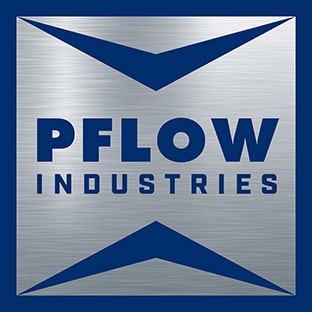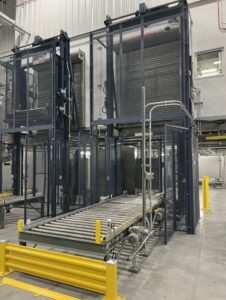Next Level: The Benefit of VRCs in Automated Facilities
Vertical reciprocating conveyors have long been the preferred option for effective warehouse workflows. Today these load-lifting workhorses remain the go-to choice for automated material handling. Here’s why:
- Ease of integration: VRCs’ flexibility and customizability means they can be built to fit in seamlessly with complex automated material handling systems.
- Optimized performance: Able to handle almost any size load and designed for speed and efficiency, VRCs can help maximize productivity and prevent bottlenecks.
- Reduced labor costs: By automating heavy lifting tasks, you’ll need fewer hands-on deck to manage material flows, allowing you to save on labor and associated costs.
- Safety: Because of their enclosed carriage structure, VRCs are safer than other lifting solutions, helping to prevent accidents and injuries.
Spiraling labor costs, just-in-time ordering, and direct-to-consumer sales are driving the need to automate every part of your supply chain — including warehousing.
As warehouse automation gathers pace, the need for safe, reliable lifting equipment capable of raising and lowering large and small loads is only going to increase.
Vertical reciprocating conveyors, or VRCs, are designed to handle a wide range of industrial lifting challenges. Robust, flexible, and almost infinitely customizable, VRCs replace stairs, ramps, forklifts, and elevators with a vertical lifting solution that can be customized to fit virtually any automated warehouse environment.
That’s why they’re as at home in today’s high-tech storage and distribution centers as they are in any other warehouse environment.
Below, we take a look at how to choose the right VRC for today’s automated warehouses. We’ll examine some of the benefits VRCs offer in automated environments and list some of the key factors you should bear in mind when selecting a VRC for your facility.
We also consider what to look for when choosing a reliable VRC manufacturer. Read on to learn more.
VRCs and Automation: 10 Key Considerations
When deciding to add a VRC to your automated warehouse system there are many considerations that factor into which VRCs best fit your application. Here are 10 key factors to consider when selecting VRC equipment for your automated warehouse.
1. Load Characteristics
Consider what you're moving. Different loads—whether they are wrapped pallets, loose machine parts, pharmaceutical vials, or cartons of eggs—have specific requirements. Gentle handling might be crucial for delicate loads, while rapid handling or platform strength might be critical for others. If smooth movement with gentle stops is important, you will likely want to consider a mechanical, rather than hydraulic, VRC.
How much space will you require for each load? Are you moving standard sized pallets, two pallet loads at one time, or are you moving small boxes? This will be important in determining the right VRC equipment.
2. Capacity, Speed, Volume and Height
What is the maximum load you will need to lift? How high do you need to lift the materials? VRCs can move loads just a few inches or dozens of feet.
More specifically, how many stops will the VRC need to make as it travels? How often will the VRC move: only as needed, or will it cycle continuously? At what speed should your VRC move to match your workflow while avoiding damage to your stock?
In general, hydraulic VRCs are good for lifting loads intermittently in two-level applications, but mechanical units are required for high-cycle or applications covering more than two-floor levels.
3. Footprint
What physical space will the VRC occupy in your facility? VRCs are often installed next to mezzanines, in existing elevator shafts, or through floors. They can also be installed outdoors.
Each option comes with its own requirements to meet safety, load-bearing, and weatherproofing requirements.
4. Load/Unload Requirements
The physical space your VRC will be installed in and its orientation to the rest of your facility will affect how it integrates with your plant’s workflows.
This will determine how materials are loaded and unloaded from the VRC and will help define what VRC design configuration is needed.
5. Physical Integration
How will your VRC integrate with the handling equipment that it needs to work with? Does the VRC need to be synchronized with an integrated conveyor or automated vehicle system, or will it be manually loaded and unloaded?
These considerations affect everything from how fast your VRC operates to the space requirements around loading points, as well as special safety and customization requirements.
6. Systems Integration
If your warehouse is already largely automated, your VRC will likely need to be integrated not only with physical equipment but with the tracking and controlling workflows through multiple systems in your facility.
Integrating VRC operations with systems monitoring while synchronizing other OEM equipment requires close cooperation. This may involve installing centrally monitored controlled sensors or visual systems to track and operate VRC equipment.
Fortunately, the flexible design of VRCs allows individual units to be customized to the level of automation required to integrate with existing equipment.
7. Specialized Environments
Specialized warehouse environments can cause unique challenges for material handling equipment. Whether your warehouse application requirements include sub-zero or high-temperature, washdown, or cleanroom environments, a VRC can be built to meeting any of these special requirements.
8. Safety Features
While safety should be considered as part of every project design decision, VRCs also need to comply with ASME B20.1 regulatory standards for conveying equipment.
Increased automation raises the stakes for safety, too. While sensors and monitoring systems mean potential hazards can be spotted sooner, increased integration also requires additional failsafe features, like easy-to-reach emergency stops.
VRCs can also be customized to include additional safety features designed to protect workers and equipment, such as lock down triggers that sound an alarm and prevent the VRC from moving if the VRC’s weight limit is exceeded.
9. Reliability and Maintenance
Successful automation requires quality equipment that performs consistently with minimum supervision. When properly maintained, quality VRC equipment should also be able to operate effectively with minimum downtime for maintenance.
Troubleshooting and maintenance are themselves now increasingly automated. For example, VRCs can be equipped with built-in remote diagnostics capabilities, enabling their performance to be monitored continuously to provide a more proactive approach to maintenance and/or repairs.
Durable, reliable VRC equipment in combination with smart maintenance and troubleshooting systems can help ensure more successful automation across the board.
10. Cost Concerns
Quality equipment designed specifically for your needs may cost more than off-the-shelf solutions. While “good enough” options might have worked in the past, fully automated operations require that every part of your integrated operation performs its role perfectly.
Many factors go into determining the cost of VRCs, including their overall capacity, special handling requirements, site-specific design challenges, as well as additional optional safety features.
As with any major investment, larger upfront costs for higher-quality VRC equipment or additional features need to be balanced against long-term return on investment in the form of future cost savings, less downtime, and increased performance.
Investing in VRC material lifting solutions is no different. Money spent wisely now on robust, closely integrated automated systems and sophisticated maintenance and troubleshooting features pay dividends of increased workflow efficiencies and cost savings over time.
PFlow: Your Trusted VRC Automation Partner
If you’re considering investing in VRC equipment for a fully automated warehouse, you need an equipment supplier with the technical skills and experience to deliver the smart, scalable, integration-ready lifting solution you’ll need today and down the line. Specifically, you’ll need:
- A manufacturer with a reputation for building and supporting durable, equipment that delivers years of operational excellence and efficiency.
- A technical partner with the expertise to deliver the customized solutions needed in highly integrated automated handling environments.
- An industry leader with the experience and skills to understand what your operation needs, and who can help you design solutions that scale as your capacity and automation grows.
At PFlow Industries we pioneered the VRC and continue to lead the industry with our robust lifting systems, designed to handle the toughest and most complex material handling applications. In fact, you could say automation is in our DNA.
Since 1977, we’ve delivered efficient, built-to-last lifting solutions to boost material handling efficiency for a vast array of industries.
Talk with us today to learn more about our fully integrated material handling solutions for complex warehousing challenges or click below to learn more about the smart, purpose-built equipment PFlow creates that can help you raise your automation game.

